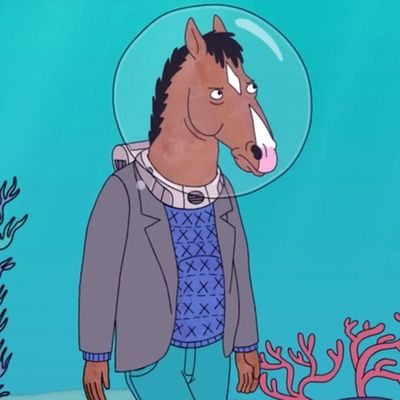
Back in June, members of team Vulture picked their favorite TV episode of 2016 at the year’s halfway point. Four weeks later, my choice (the Jenny Slate episode of Girls) has already been unseated by the fourth episode of BoJack Horseman’s third season, which premiered today on Netflix. “Fish Out of Water,” a.k.a. the underwater episode, plays out as if the iconic Looney Tunes director Chuck Jones were tasked with doing a Charlie Chaplin–inspired Fantasia segment. It also has my favorite joke of the year (but more on that in a bit). Tonally and formally inventive, silly and bittersweet, visually and sonically beautiful: It’s a much-watch, and the best part is, you don’t have to have watched a single other episode of the series to love it.
From this point on, I will be revealing some specifics from the episode, but they’ll hardly kill the joy of watching — words cannot spoil an episode that has almost none. It would be like if I listed the fish in (insert best sushi restaurant in your area here)’s omakase: It would increase your anticipation, but take nothing away from the pleasure of consuming it.
Speaking of fish, the episode is set almost entirely underwater. In what can be best described as Farside-esque, the episode is a fish-out-of-water story set in water. See, as they explain at the top of the episode, depressive actor-horse-humanoid BoJack Horseman, in his campaign for an Oscar, needs to make an appearance at a film festival, and the only one that’ll have him is deep in the Pacific Ocean. Here’s where things get interesting: Because he’s underwater and wearing a scuba-like helmet, BoJack can’t speak. The only speech throughout most the episode is an untranslated fish language.
On the phone earlier this week, BoJack creator Raphael Bob-Waksberg said the episode was born out of a desire to find a “different kind of story.” “What’s an avenue for storytelling that we haven’t explored?” he said. “Both the underwater aspect and the dialogue-free aspect felt like a fun challenge to pursue.” Bob-Waksberg said they enjoyed giving the show’s director, Mike Hollingsworth, and his animation team an opportunity to really flex their muscles, as the show is usually so dialogue-packed. As a result, it feels almost like a tribute to the power of animation.
The episode was tightly scripted, says Bob-Waksberg, with the episode’s writers, Jordan Young and Elijah Aron, spelling out everything that happens. “They took this thing that none of us knew how to write,” said Bob-Waksberg, “and did a really good job writing a full script without the dialogue, describing everything meticulously: ‘Bojack walks from the doorway to his bed. He sits down. Looks at his cigarette. How’s he gonna light that?’” But, as Bob-Waksberg put it, the animators “went to town on it.” Especially in scenes without talking, animators are essentially the actors, depicting emotion in the characters’ facial expressions and body language. (In “Fish Out of Water,” you might describe the animators’ performance as similar to Robert Redford’s wordless one in All Is Lost.) There’s a scene towards the end where a seahorse wants to repay BoJack for a good deed. There is no intelligible dialogue, but you can tell the seahorse asks BoJack, “What do you want?” His answer, or lack thereof, is all over his drawn face. He doesn’t know. He looks at the family of seahorses. He still doesn’t know. A point that might have felt heavy-handed if spoken becomes intensely personal.
Structurally, tonally, and thematically, the episode is most reminiscent of Sofia Coppola’s Lost in Translation. It’s an episode about the inability to communicate, both literally and figuratively, and the isolation that results. Not only can BoJack not speak with the sea-vilians, but the throughline has him trying to tell Kelsey Jannings — a director he got fired from a movie — that he’s sorry by writing her a note. The episode then uses the physical obstacles put in front of him (he’s about to hand her a note, for example, but is forced on a bus by a stampede of sardines) with the mental obstacles he self-imposes as a horse afraid to be vulnerable and direct with others.
It all feels less like an episode of television and more like a short film. The relationships and stakes for BoJack are clearly laid out in the first five minutes, as is who BoJack is as a character — primarily in a series of terrible note drafts he attempts to write to Jannings — so anyone could just dive into it. (Though, there are jokes for regular watchers as well: namely, the payoff to Mr. Peanutbutter’s seahorse milk endorsement deal.) I suggest BoJack newcomers actually start with this episode. So often do we demand people begin with the first episode of a TV show, despite the fact that pilots are almost always worse than the rest of the series. Here is an opportunity to see the show at it’s full potential (and, thanks to Netflix, with no commercial breaks, which would completely ruin the experience), while still getting the gist of what makes BoJack Horseman BoJack Horseman.
That’s because, despite being so unconventional, “Fish Out of Water” still functions as a perfect BoJack Horseman episode, thanks to the joke at the end.
Spoiler alert: Seriously, at this point in the essay, it’s only for people who have watched the episode or don’t care that I’m going to straight-up reveal the ending.
After 20 minutes of no talking, BoJack sees Jannings leaving the hotel. He chases her down to give her a new and improved apology. He swims down to her cab (kind of like the ending of Lost in Translation), and hands her the note. She looks, has almost no reaction, hands it back, and tells the cabbie to drive. BoJack looks down at the note and realizes the whole being underwater thing has caused his writing to smudge. It’s gibberish. It’s heartbreaking. And then we hear, “Hey! Move it, buddy.” Zoom out, and there is a dude pressing a button on the side of his helmet. One more button-press: “What are you deaf?” It’s the silly version of a Shyamalanian twist: He could talk the whole time. The entire episode to that point is a setup to that punch line. It’s Wile E. Coyote running past the cliff’s end, and this moment is him looking down. The moment he “falls” comes in BoJack’s reaction: “Oh, you have got to be kidding m…” he says, before being cut off by the end credits. It’s a classic joke structure, and classic BoJack. “It’s just like BoJack to puncture a beautiful, emotional, gorgeous, well-crafted episode by shouting at the end and not quite letting it be,” Bob-Waksberg explained.
This is BoJack at it’s best, contrasting high and low. The balance of these two elements defines the show’s tone: Yes, BoJack Horseman is a searingly honest depiction of addiction, depression, and self-destructive behavior. But it’s also a show about talking animals.


